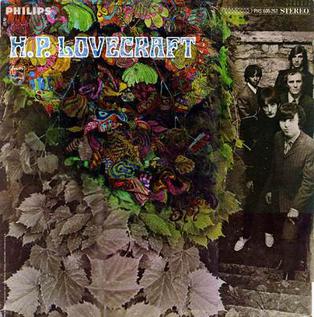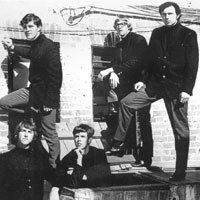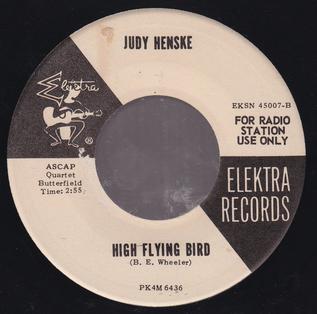
Country Joe and the Fish was an American psychedelic rock band formed in Berkeley, California, in 1965. The band was among the influential groups in the San Francisco music scene during the mid- to late 1960s. Much of the band's music was written by founding members Country Joe McDonald and Barry "The Fish" Melton, with lyrics pointedly addressing issues of importance to the counterculture, such as anti-war protests, free love, and recreational drug use. Through a combination of psychedelia and electronic music, the band's sound was marked by innovative guitar melodies and distorted organ-driven instrumentals which were significant to the development of acid rock.

The Shadows of Knight were an American rock band from Chicago, Illinois, that played a version of British blues influenced by their native city. When they began recording in 1965, the band's self-description was "the Stones, Animals and the Yardbirds took the Chicago blues and gave it an English interpretation. We've taken the English version of the Blues and re-added a Chicago touch," to which rock critic Richie Unterberger commented: "The Shadows of Knight's self-description was fairly accurate."
Dunwich Records was an independent American record label started by Bill Traut, Eddie Higgins and George Badonsky in Chicago in 1965. Dunwich was also a production company which licensed recordings to other labels, including Atlantic, Atco, Columbia, Mercury and SGC. The label was primarily known for the release of singles from the emerging Chicago rock scene in the 1960s. Only two artists, the Shadows of Knight and Amanda Ambrose, released albums on the label.

The Music Machine was an American rock band formed in Los Angeles, California in 1966. Fronted by chief songwriter and lead vocalist Sean Bonniwell, the band cultivated a characteristically dark and rebellious image reflected in an untamed musical approach. Sometimes it made use of distorted guitar lines and hallucinogenic organ parts, punctuated by Bonniwell's distinctively throaty vocals. Although they managed to attain national chart success only briefly with two singles, the Music Machine is today considered by many critics to be one of the groundbreaking acts of the 1960s. Their style is now recognized as a pioneering force in proto-punk; yet within a relatively short period of time, they began to employ more complex lyrical and instrumental arrangements that went beyond the typical garage band format.
Psychedelic folk is a loosely defined form of psychedelia that originated in the 1960s. It retains the largely acoustic instrumentation of folk, but adds musical elements common to psychedelic music.

Terrence Orlando "Terry" Callier was an American soul, folk and jazz guitarist and singer-songwriter.

H. P. Lovecraft was an American psychedelic rock band, formed in Chicago, Illinois, in 1967 and named after the horror writer H. P. Lovecraft. Much of the band's music was possessed of a haunting, eerie ambience, and consisted of material that was inspired by the macabre writings of the author whose name they had adopted. Combining elements of psychedelia and folk rock, the band's sound was marked by the striking vocal harmonies of ex-folk singer George Edwards and the classically trained Dave Michaels. In addition, Michaels' multi-instrumentalist abilities on organ, piano, harpsichord, clarinet and recorder provided the band with a richer sonic palette than many of their contemporaries.
Charles Ethan Kenning is an American singer, songwriter and musician who performed as George Edwards when he led 1960s acid rock band, H. P. Lovecraft. He was adopted as a child and brought up under the name George Edwards. He reverted to his birth name of Ethan Kenning in his mid-30s.
Jerry McGeorge came to prominence in late 1965 as an American guitarist with the Chicago rock band The Shadows of Knight. He later joined the psychedelic rock band H.P. Lovecraft on bass in the summer of 1967, appearing on their debut album, H. P. Lovecraft.
David Miotke is an American keyboard player and singer, who under the name Dave Michaels was co-founder of the 1960s acid rock band H. P. Lovecraft.

The Pentangle is the 1968 debut album of the band Pentangle: Terry Cox, Bert Jansch, Jacqui McShee, John Renbourn and Danny Thompson. It brought together their separate influences of folk, jazz, blues, early music and contemporary songwriting. One of the band's most commercially successful albums, it reached number 21 in the British charts.

The Stone Poneys is the debut studio album by the Stone Poneys; other than the single of "So Fine" in 1965, this album marks the first official recordings by Linda Ronstadt.

Live May 11, 1968 is a live album by the American psychedelic rock band H. P. Lovecraft and was released in 1991. The eight tracks included on the album were all recorded at The Fillmore in San Francisco, California, on May 11, 1968, soon after the band's original bass player Jerry McGeorge had been replaced by Jeffrey Boyan. The album consists of material taken from the band's first two studio albums and features very good sound quality considering the era in which it was recorded.
Not to be confused with Styx (band)

H. P. Lovecraft is the debut album by the American psychedelic rock band H. P. Lovecraft. It was released in October 1967 by Philips Records.
"The White Ship" is a song released by the American psychedelic rock band, H. P. Lovecraft, in November 1967. The songwriting is credited to band members George Edwards, Dave Michaels, and Tony Cavallari. Acting as the opening song on the second side of their debut LP, H. P. Lovecraft, it was the album's longest track, and an edited version was also released as the band's second single. The name and theme of the song derive directly from author H. P. Lovecraft's short story, "The White Ship". Despite its failure to chart nationally, it is widely considered to be H. P. Lovecraft's most accomplished piece, and helped establish the group, who were originally from Chicago, in the West Coast music scene.

"Smell of Incense" is a song by the American psychedelic rock band the West Coast Pop Art Experimental Band, written by Ron Morgan and Bob Markley, and was released as a single on Reprise Records in 1968.

The E-Types were an American garage rock band formed in Salinas, California, in 1965. The group's sound combined striking three-part vocal harmonies and Jody Wence's jangling keyboards, with professional production techniques that were outside of the garage band norm. During the E-Types' recording career, the band released five singles, including their most notable record "Put the Clock Back on the Wall". Although the band was short-lived, the E-Types had a profound presence in San Francisco's live scene and, years after their disbandment, the group recorded a reunion album.
William Raymond Traut was an American jazz musician, rock music producer, manager and record label executive. He co-founded the Dunwich and Wooden Nickel record labels, and produced The Shadows of Knight, The American Breed, the Siegel-Schwall Band, and Styx, among others.

"High Flying Bird" is a song written by American folk and country singer-songwriter Billy Edd Wheeler, and first recorded by Judy Henske in 1963. It was performed and recorded by many musicians and groups in the mid and late 1960s, and was influential on the folk rock genre.












